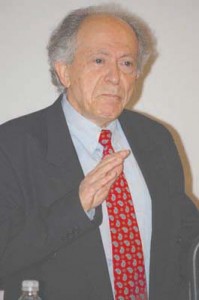Tamar Karkazian
Staff Writer

Armenian identity and the Genocide—we don’t expect to hear topics like this until April, when we, as a community, come together to commemorate the Armenian Genocide. However, this was the topic of discussion on Wednesday evening, February 17. Dr. Abraham Terian, the eighth Henry S. Khanzadian Kazan Visiting Professor in Armenian Studies at Fresno State gave his first lecture, “Armenian Identity and the Genocide,” in a series of three lectures under the general title of “In the Darkness of Genocide.” The goal of these lectures is to bring both awareness and inspiration to listeners.
The Armenian Studies Program hosted a reception in the Gottschalks Gallery of the University Business Center before the lecture. As guests arrived, they were greeted with a buzz of excitement and anticipation. A beautiful table filled with food was the centerpiece for the reception.
“I look forward to hearing what Dr. Terian has to say,” said Faten Miyaznih, President of the Armenian Students Organization, “It seems like it will be an interesting topic.” There was a diverse audience of Fresno State students, faculty, and community members present.
Prof. Barlow Der Mugrdechian, Coordinator of the Armenian Studies Program, introduced Dr. Terian, who began the lecture by discussing how the Armenian national/ethnic identity is closely tied to Christian religious identity. He went on to underscore the uniqueness of Armenian Christianity and to show continuity between the Armenian faith and the Genocide.
Dr. Terian stated that Armenians in general blend Armenian identity with their Christian identity. The first piece of literary evidence he discussed was Koriun’s Life of Mashtots the first book ever written by an Armenian. Dr. Terian explained how since Life of Mashtots, “the Armenian identity was set in stone.” He continued on to explain that 99% of Armenian manuscripts were religious, and that we know of only a small percentage of those works. Dr. Terian elaborated by drawing an analogy, saying that “The published work is a tip of a pencil and the amount of literature unknown to us is the rest of the pencil.”
The motivation for the development of an Armenian alphabet also has to do with religion. Mesrop Mashtots’s motivation for creating an Armenian alphabet was to translate the Bible. In 406 A.D. Mashtots and a group of early writers translated the Bible, at first from a Syriac manuscript and then later from Greek manuscripts.
Armenian history is closely tied to its Christian identity. Many battles were fought to keep the faith, such as the Battle of Avarayr in 451. Much of the suffering the Armenians have endured as a nation has been for Christianity, according to Prof. Terian.
Dr. Terian concluded his lecture by saying that the main reason Armenians were executed during the late 19th and early 20th centuries was because of their Christianity. It is also why the Ottoman Turks tried to eliminate the Armenians in the Genocide. Although some 250,000 Armenians were forcibly converted to Islam, a vast majority died as martyrs for their religion. The Genocide was the price Armenians paid for being Christian.
Dr. Sergio La Porta of the Armenian Studies Program was a discussant following the lecture. Questions and answers concluded the lecture.
 Hye Sharzhoom Armenian Action
Hye Sharzhoom Armenian Action